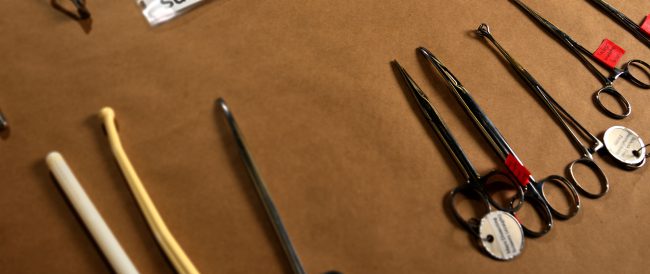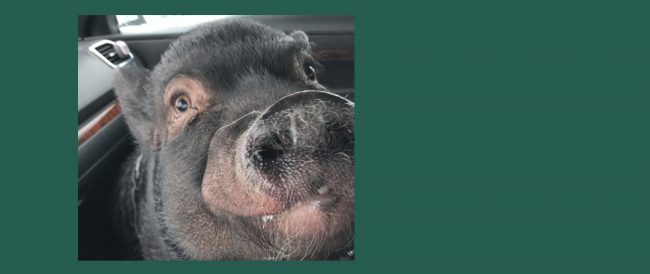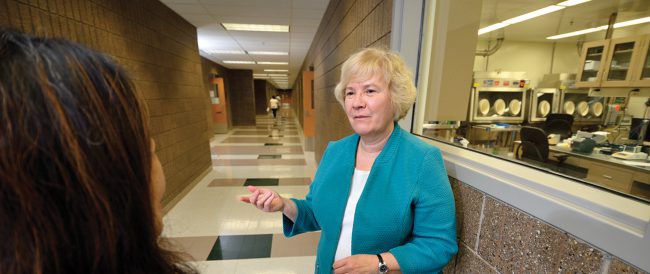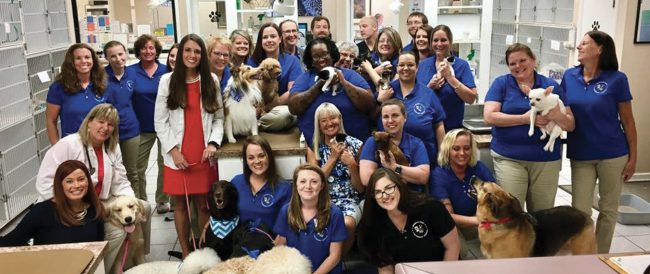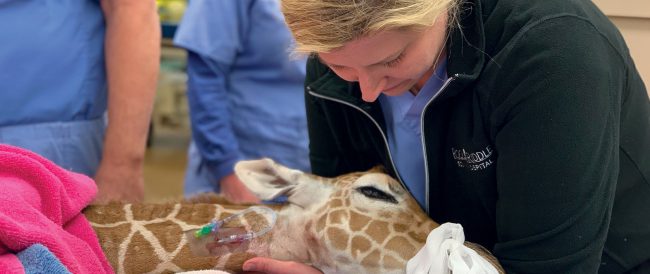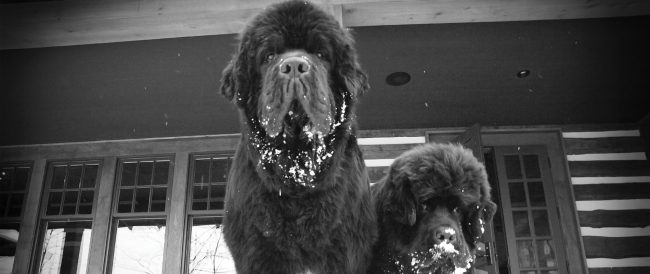 Read More
Read More
For some, birthday wishes do come true. After 16 years of blowing out candles with the wish of owning a pet, Skylar Gray was gifted what she’d always wanted—a pig. Violet Gray, Gray’s pot-bellied pig, quickly became the center of her world.
For some, birthday wishes do come true. After 16 years of blowing out candles with the wish of owning a pet, Skylar Gray was gifted what she’d always wanted—a pig. Violet Gray, Gray’s pot-bellied pig, quickly became the center of her world.
“I had no idea the effect Violet would have on my life,” says Gray. As a 16-year-old without a job, Gray found that much of Violet’s care was doable. However, there was one large expense that she never seemed to be able to save up for: getting her spayed
“Thank you—thank you so much for giving me my healthy girl back. It is because of you that I can expect Violet to be around for a long, long time.”
— Skylar Gray,
Violet’s owner
In pigs, sheep, and cattle, repeated estrus cycles (commonly called “heat”) without pregnancy increase the amount of estrogen exposure that can promote uterine and reproductive organ complications such as endometrial hyperplasia, a condition in which the lining of the uterus becomes abnormally thick.
“Violet remained intact for eight years. Fortunately, we experienced no issues during that time,” says Gray. “Then, like clockwork, at the beginning of her heat cycle in August 2018, I noticed she had some protruding tissue from her vaginal area.” The issue resolved itself in less than a day, so Gray waited to have the area examined until Violet’s already-scheduled check-up a few weeks later at the Michigan State University Veterinary Medical Center’s Large Animal Clinic.



During Violet’s heat cycle the following month (September 2018), she had significantly more protruding tissue, except this time, it didn’t resolve on its own. “I spoke with Dr. Strachota at the MSU Large Animal Clinic and was able to get Violet in to be examined that same day,” says Gray, who hung up the phone, gathered Violet, and headed to MSU. After Violet was examined by several veterinarians, she was sedated so that the protruding tissue could be removed and tested.
Violet was able to go home that same day, but she wasn’t completely in the clear; a sample of the tissue was submitted for biopsy in order to diagnose the cause of its protrusion. The possible diagnoses were cystic endometrial hyperplasia (CEH, a condition in which an excessive number of cells in the inner lining of the uterus cause the crowding and budding of the glands and gland cells) or neoplasia (the presence or formation of new, abnormal growth of tissue).

Two weeks after receiving the diagnosis, Gray dropped Violet off at the Hospital. She had tried to have Violet spayed earlier in the year, but due to a bad reaction to the anesthesia, the procedure couldn’t be done. This time around, and knowing her history with anesthesia, there were three anesthesiologists in the operating room with Violet at all times. “I hated to leave her alone, but knew she was in good hands,” says Gray. The next day, Gray came back to MSU for Violet’s procedure. “I was allowed to watch; it wasn’t easy seeing her like that (in surgery), but knowing what was happening eased my nerves.”
Post-surgery, Violet was returned to her stall. She remained under observation throughout the rest of the day and night. “The amount of care and attention that Violet was given are part of what made such a stressful day more bearable,” says Gray.
The following day, Gray returned to MSU to take Violet home. “When I got to MSU to pick her up, she was back to herself; sassy, opinionated, and stubborn, but sweet, loving, and snuggly,” says Gray.
“I am so grateful to Dr. Strachota, Dr. Jacobs, and everyone else who made Violet’s care exceptional during her time at MSU. Thank you—thank you so much for giving me my healthy girl back. It is because of you that I can expect Violet to be around for a long, long time.”
Spartan Story: A Desire to Always do What’s Best for Animals—and Their Owners

“I love animals,” says Dr. Julie Strachota, assistant professor for the Department of Large Animal Clinical Sciences. “I’ve known I wanted to be a veterinarian since I was a child.”
Strachota’s parents grew up around livestock, and that love for animals was genetic. For Strachota, that passion cemented when she turned 16 and was entrusted with her very own horse. “I spent hours every day at the farm, grooming and riding my mare,” says Strachota. “All this time I spent around horses really solidified my passion for veterinary medicine. It also allowed me to develop invaluable horsemanship skills.”
Strachota’s family owned three broodmares, which they bred for a few years. “I was exposed to many different aspects of equine veterinary medicine, from theriogenology to sports medicine,” says Strachota. “As an undergraduate student at Michigan State University, I traveled to Colorado State University to learn more about caring for broodmares, foals, and stallions.” Her family also showed their horses around the country, which exposed her to different techniques and practices in veterinary medicine.
After completing her undergraduate degree and DVM at Michigan State University, Strachota became an associate at an equine-exclusive practice in Michigan. “I developed my passion for theriogenology there, as I worked on a variety of different breeds
of horses. I had the opportunity to breed a mare, flush the embryo, implant the recipient mare, and then foal the recipient mare out. It is such an accomplishment when you see the embryo under the microscope and get to follow that pregnancy through parturition,” says Strachota.
Though Strachota has always had a love for horses and other animals, caring for them in a veterinary setting didn’t always come easy to her. “When I was an undergrad at MSU, I took a three-semester detour from pre-veterinary science to become a special education teacher,” says Strachota. “I made the major change because I was very concerned about having to euthanize animals. I conquered this fear by shadowing and working in a variety of veterinary clinics.”
A desire to always do what’s best for animals—and their owners—is what drove Strachota back to veterinary medicine and led her to pursue a non-traditional residency at MSU. Her role, which began in 2018, focuses on clinical teaching in large animal medicine with special attention to equine primary care and comparative theriogenology.
“I pursued my residency, not only because I love animals, but because I feel like I have a kinship with the owners who are attached to their animals. Many owners view their pets as beloved family members, as I did with my horses,” says Strachota. “When they bestow me with caring for their animal, I am honored and obligated to do the very best for that patient. That’s why I chose to leave private practice and further my education in theriogenology by doing a non-traditional residency. I want to make sure I’m doing my very best for my clients and their animals.”
This is a theme that Strachota carries with her in all that she does—as a veterinarian, a student, and as a teacher. Because of this commitment, and all that comes with it, she believes it’s very important to be humble. “I think it’s okay to tell a client or colleague that you don’t know the answer to a question they asked you; you may not know it at the moment, but you will figure it out.”
She also stresses the value of being 100 devoted to the work you’re doing, regardless of which rotation you’re on, case you’re facing, or lesson you’re learning. “If you treat every rotation like it’s what you’re going to be doing for the rest of your life, you will fully submerge yourself in the discipline and get the most out of your time on that rotation.”
She applies that mindset to all that she does, and though doing so reaps many rewards—deep relationships with clients and colleagues, and membership in a collaborative team that cares for animals—it also has its challenges. “Not every animal can be treated successfully, and having those conversations with owners, especially owners that I’ve developed a bond with, can be very difficult,” she says. “At the end of the day, I just have to remind myself that my goal is to do what is best for the animal and the owner.”
Her dedication to healing animals, and her commitment to her values as a veterinarian, can be seen in Violet’s case, the pot-bellied pig with cystic endometrial hyperplasia. “Violet’s case was rewarding in many ways; Violet was a beloved pet to her owner for a large portion of her life, and her owner only wanted what was best for Violet, she says. “Though there were some financial constraints, we were able to cure Violet by performing an ovariohysterectomy. The appreciation that Violet’s owner had for the entire staff makes what we do every day worth it.”
It’s cases like these that remind Strachota why she’s always loved animals, and why she’s meant to be a veterinarian. They also remind her of why she gets such joy from sharing her passion, experience, and values with future veterinary professionals. “When veterinary medical students pass their board exams, they are veterinarians of all animals. I think it’s important that they be exposed to different species during veterinary medical school so they can find something they’re passionate about—and so they can be knowledgeable about all species. At the end of the day, we’re all colleagues who care for animals to the best of our ability.”
“When they bestow me with caring for their animal, I am honored and obligated to do the very best for that patient. That’s why I chose to leave private practice and further my education in theriogenology by doing a non-traditional residency. I want to make sure I’m doing my very best for my clients and their animals.”


